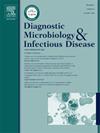Hidden threats: Brucellosis diagnosis and co-infection patterns in Crimean-Congo Hemorrhagic Fever suspects
IF 2.1
4区 医学
Q3 INFECTIOUS DISEASES
Diagnostic microbiology and infectious disease
Pub Date : 2025-01-30
DOI:10.1016/j.diagmicrobio.2025.116724
引用次数: 0
Abstract
Purpose
This study aims to investigate the frequency of brucellosis in patients with Crimean-Congo Hemorrhagic Fever (CCHF).
Method
In this study, 1231 patients were evaluated retrospectively, including 14 patients with CCHF and brucellosis coinfection and 25 patients with brucellosis alone. Statistical methods such as the Mann-Whitney U test and Fisher's exact test were used.
Result
Of the patients with a preliminary diagnosis of Crimean-Congo Hemorrhagic Fever (CCHF), 3.2% were found to have brucellosis. In the group co-infected with brucellosis and CCHF, the time to hospital admission was shorter. Additionally, tick exposure and headache were observed more frequently in this group. Creatine kinase levels were found to be higher in the co-infected group, while lymphocyte counts and fibrinogen levels were lower compared to the group with brucellosis alone.
Conclusion
Our study revealed a 3.2% rate of brucellosis in patients with a preliminary diagnosis of CCHF. Due to the similarity of symptoms and common risk factors, the differential diagnosis of brucellosis should be considered in patients diagnosed with CCHF. Additionally, the possibility of brucellosis coexisting with CCHF should always be considered. Even in patients diagnosed with CCHF, an evaluation for brucellosis must be conducted.
求助全文
约1分钟内获得全文
求助全文
来源期刊
CiteScore
5.30
自引率
3.40%
发文量
149
审稿时长
56 days
期刊介绍:
Diagnostic Microbiology and Infectious Disease keeps you informed of the latest developments in clinical microbiology and the diagnosis and treatment of infectious diseases. Packed with rigorously peer-reviewed articles and studies in bacteriology, immunology, immunoserology, infectious diseases, mycology, parasitology, and virology, the journal examines new procedures, unusual cases, controversial issues, and important new literature. Diagnostic Microbiology and Infectious Disease distinguished independent editorial board, consisting of experts from many medical specialties, ensures you extensive and authoritative coverage.

 求助内容:
求助内容: 应助结果提醒方式:
应助结果提醒方式:


